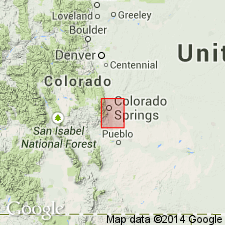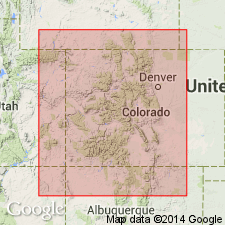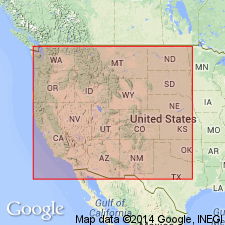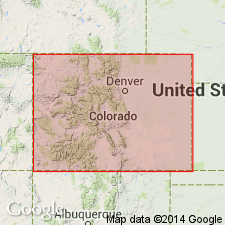
- Usage in publication:
-
- Mount Rosa granite*
- Modifications:
-
- First used
- Dominant lithology:
-
- Granite
- AAPG geologic province:
-
- Southern Rocky Mountain region
Summary:
First published use as a name applied to a granite that occurs on the slopes of Mount Rosa [source of name], Teller Co, CO. This main granite mass extends east into El Paso Co. Several smaller bodies occur to south near South Cheyenne Creek, and one body occurs to north along North Cheyenne Creek. Area lies in the Southern Rocky Mountain region. No type locality designated. Has intruded the Pikes Peak granite as irregular masses, sheets, and dikes. Forms resistant, bold outcrops. Consists of fine-grained nonporphyritic blue-gray granite made up mostly of microcline, quartz, and riebeckite. Quartz and microcline make up about three-fourths of the rock; quartz being slightly more abundant than microcline. Riebeckite makes up about one-fifth of the rock. Zircon is the most common accessory mineral. Chemical analyses. Geologic map. Of pre-Cambrian age.
Source: GNU records (USGS DDS-6; Denver GNULEX).

- Usage in publication:
-
- Mount Rosa Granite*
- Modifications:
-
- Overview
- AAPG geologic province:
-
- Southern Rocky Mountain region
Summary:
Alkalic riebeckite granite in small bodies intrusive into Pikes Peak Granite and other rocks of composite Pikes Peak batholith. Listed with granitic rocks of circa 1,000 m.y. (Precambrian Y) age group. Is in Southern Rocky Mountain region.
Source: GNU records (USGS DDS-6; Denver GNULEX).

- Usage in publication:
-
- Mount Rosa Granite*
- Modifications:
-
- Geochronologic dating
- AAPG geologic province:
-
- Southern Rocky Mountain region
Summary:
Pg. 14, geologic time scale (inside front cover). Mount Rosa Granite. Sample from Mount Rosa, Pikes Peak area, approx. Lat. 38 deg. 44 min. 50 sec. N., Long. 104 deg. 57 min. W., Mount Big Chief quadrangle, Teller or El Paso County, Colorado, yielded a Pb-alpha age of 1,110 +/-125 Ma (zircon). Age calculated using decay constants of Steiger and Jager, 1977 (Earth Planet. Sci. Letters, v. 36, p. 359-362). Age of Mount Rosa is near 1,000 Ma [Precambrian Y]; Pb-alpha age mentioned by Gross and Heinrich (1965, Amer. Mineral., v. 50, p. 1273-1295).
Source: Publication.

- Usage in publication:
-
- Mount Rosa Granite*
- Modifications:
-
- Areal extent
- Overview
- AAPG geologic province:
-
- Southern Rocky Mountain region
Summary:
Is a blue-gray, fine- to coarse-grained riebeckite granite in southern part of the Pikes Peak batholith, CO in Southern Rocky Mountain region. Occurs in elongate bodies about 10 km sq (4 mi sq) in an arc nestled against the inner side of the arc of fayalite granite. Assigned to the Middle Proterozoic.
Source: GNU records (USGS DDS-6; Denver GNULEX).
For more information, please contact Nancy Stamm, Geologic Names Committee Secretary.
Asterisk (*) indicates published by U.S. Geological Survey authors.
"No current usage" (†) implies that a name has been abandoned or has fallen into disuse. Former usage and, if known, replacement name given in parentheses ( ).
Slash (/) indicates name conflicts with nomenclatural guidelines (CSN, 1933; ACSN, 1961, 1970; NACSN, 1983, 2005, 2021). May be explained within brackets ([ ]).

